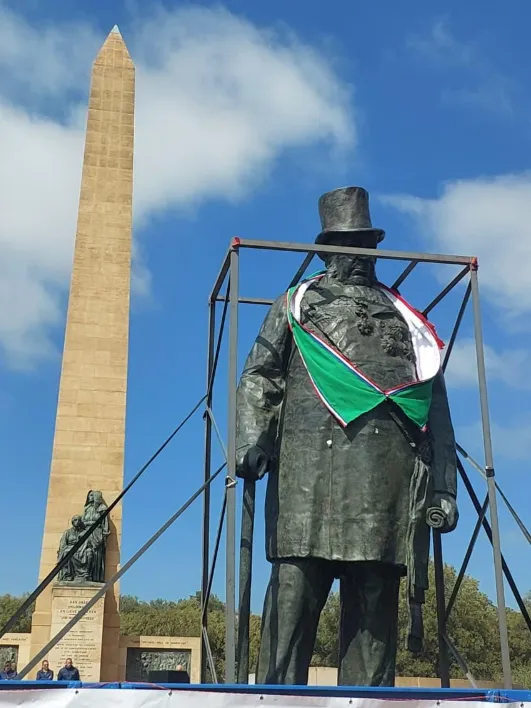Kruger statue tours two historic capitals in one day

The four-metre Paul Kruger statue’s heritage tour reached a milestone on October 1, visiting Bloemfontein and Kimberley in a single day and drawing large crowds for ceremonies, performances and community gatherings reflecting on Afrikaner history, culture and identity.
Image: Supplied
THE TRAVELLING heritage tour of the four-metre bronze Paul Kruger statue, a replica of the one in Church Square in Pretoria, reached a significant milestone on October 1 when it visited two provincial capitals in a single day. Both Bloemfontein and Kimberley carry rich historical ties to the Kruger era, and the visits sparked renewed conversation about the relevance of Kruger and Afrikaner heritage in modern times.
A Monument of Pain and Hope
The day began at the National Women’s Monument in Bloemfontein, erected in 1913 to honour the suffering of women and children during the Anglo-Boer War. The Kruger statue stood poignantly against this backdrop, reminding visitors of a history marked by hardship and sacrifice.
“For me, it is remarkable that the Women’s Monument was built at a time when the Afrikaner endured so much hardship,” said Cara Tomlinson, tour leader and cultural co-ordinator for the Federation of Afrikaans Cultural Associations (FAK) in the Northern Cape. “Today, when we again face economic and social challenges, we are building a statue – a beacon that reminds us of who we are and what we can hold on to.”
The ceremony was opened by Reverend Henri Scherman of the Afrikaanse Protestantse Kerk in Bloemfontein, followed by a lecture from historian Professor Andries Raath, who spoke about Kruger’s leadership and principles in the broader context of Afrikaner identity. Frans de Klerk of the Orania Movement shared insights into the construction of the statue’s pedestal in Orania and how symbolic stones can be purchased to help fund it.
Around 160 people attended the event, including schoolchildren and community leaders. A wreath-laying ceremony at the monument created a moving moment that linked past generations to the present.
Culture and Education Hand in Hand
The tour then moved to Dankbaar CVO School, where Orania’s OKeR drama group performed Kruger Breek die Pad Oop, NP van Wyk Louw’s play depicting perseverance and leadership. The performance struck a chord with pupils, teachers, and parents alike.
“The children didn’t just see history – they felt it,” said Tomlinson. “They realised that Kruger’s heritage is also their heritage.”
Dawid Brand, head of media, marketing and tourism at Kultuurtuiste, added: “The warm reception at the Women’s Monument and the school showed how Afrikaner culture, education and faith still walk hand in hand today.”
Paardeberg – Remembering Sacrifice
Next, the group visited the historic battlefield of Paardeberg, where General Piet Cronjé and his troops surrendered to British forces in February 1900. About 50 community members gathered to welcome the tour, offering food and refreshments as a gesture of hospitality.
The quiet simplicity of the occasion underscored the reminder that heritage lives not only in monuments and statues, but also in the shared memories and actions of ordinary people.
Kimberley – A Community Celebration
The tour concluded in Kimberley at the NG Church Bakenkop, where about 150 people gathered for a moving programme. Reverend Schalk Albertyn of Orania opened with a message on faith and perseverance, followed by Carel Boshoff, FAK chairperson, who spoke about the symbolic value of the statue in building community.
A highlight was the presentation of a certificate of appreciation to Marius Nagel for his years of dedicated work in preserving Afrikaner heritage in Kimberley. His role in organising the event was warmly recognised.
The new CVO school, recently established in Kimberley, also attended, giving young learners an early connection to a broader heritage project.
“The visits to Paardeberg and Kimberley showed how history, faith, and community converge in the Kruger tour,” said Brand. “Wherever the statue goes, it sparks conversations, memories, and new bonds among people.”
He added that Kruger remains more than a political leader of the 19th century: “He represents principle, independence, and faith. His legacy provides guidance for a community once again grappling with economic pressures and cultural challenges.”
On the day, 18 symbolic stones for the statue’s pedestal were sold. The statue is set to be officially unveiled on October 10 in Orania’s planned town centre, with each stone serving as both a financial contribution and a tangible link to Kruger’s legacy and the Afrikaner pursuit of identity.
Related Topics: